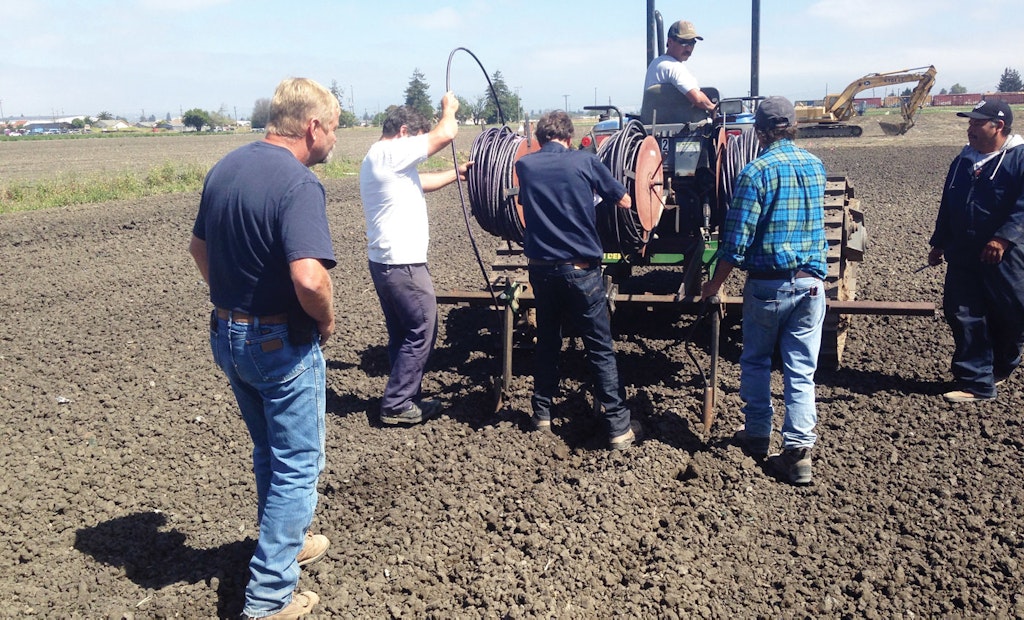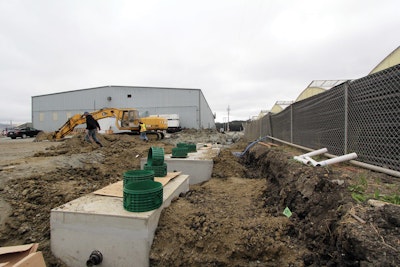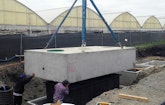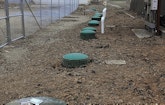
Installing about 13,000 feet of Geoflow drip tubing was a quick task for the workers at Lakeside Organics because of the tool they made. They put three tube installers on a farm toolbar and did the job in short order.
The building near Watsonville, California, was used for sorting flowers grown in nearby fields when clients Lakeside Organics and Farmhouse Culture approached engineer Ken Mabie about a project.
Farmhouse Culture makes sauerkraut, and because of a new contract with discount wholesaler Costco, the company needed more production space than it had in nearby Santa Cruz. Lakeside Organics wanted Mabie to help convert its flower-sorting building, with a low wastewater flow, into a processing factory that would make cabbage into sauerkraut.
“This became a perfect marriage because Lakeside Organics grows the organic cabbage that Farmhouse Culture wants to make the sauerkraut out of and grows it in the fields around this area. So they could supply the product to Farmhouse Culture, and Lakeside Organics also supplied the building and the processing operation,” Mabie says.
Scaling up and up
The only wastewater system in place when Mabie started the project was a small one to handle a restroom for workers.
“I started out the design with a leachfield system in one of the farm fields there. We had plenty of space, and it’s flat. The soils are not terrific, but they’re not horrendous. They’re a silty loam, so they accept water but not at a high rate,” he says.
The water to be treated was predominantly wash water used to rinse barrels, floors, and the equipment. Mabie initially proposed piping the water into ponds, but the state Water Quality Control Board would not allow it without a National Pollutant Discharge Elimination System permit. Mabie’s next step was to look at alternative technology.
First Mabie took water samples from the Santa Cruz factory. Those tell a manufacturer what the water chemistry will be like, and if you skip that step, you may get a product that cannot do the job, he says. In this case, the samples went to BioMicrobics, which worked closely with the team in California to design a system that would clean the factory wastewater.
“They informed us early on they may go to three shifts, a 24-hour operation except for weekends. So the flow took a quantum leap,” Mabie says. “But you don’t want to build a system too big for the need because they don’t operate properly.”
A nice point about this system is it’s modular, he says. If the plant expands in the future, it is possible to pipe in more tanks and expand the size of the dripfield to accommodate an increased flow.
The modularity also comes from the way Mabie designed the system, says Bryan Chiordi, area representative for Green Technology Solutions in Mission Viejo, California. The system is placed on the property so additional equipment could be placed beside the existing equipment and connected through a manifold.
Flexible design
The wastewater flow posed its own challenges.
In a residence, there is a balance between carbon and nitrogen, so it’s easy to reduce the nitrogen using a conventional aerobic system, Mabie says. In this situation, the equipment had to be carefully designed to work with what was coming out of the sauerkraut factory. Predominantly that meant a lot of carbon from cabbage trimmings.
The vinegar used in the process, and washed out of equipment, also posed a problem because of its effect on pH and the bacteria in the treatment tanks, Chiordi says. That made the contributions of BioMicrobics scientists invaluable, he says.
Initially the system has not required any adjustment for pH, but there is a spot in the treatment chain where an automatic chemical feed can be installed to supply that.
The water table was at about 4 feet.
“And that’s not a surprise. This is a big, flat valley, and the Pajaro Valley is a huge producer of various crops, strawberries, lettuce, bush berries, there’s an apple orchard. They kind of call our area in Salinas the salad bowl of the world,” Mabie says.
Because of widespread nitrogen contamination of wells from agricultural operations, Monterey County also has a nitrogen standard. The system had to meet a limit of 6 mg/L of nitrate nitrogen.
Treatment chain
The solution worked out by the team resides in a line of five tanks placed not too far from the factory building.
Wastewater first enters a 5,000-gallon equalization tank made by Jensen Precast in Sacramento. (This is one of the few companies in California that manufacture tanks that large, Mabie says.) The tank is outfitted with two Tsurumi PU50 pumps and BioSTEP filters. An SJE-Rhombus IFS1 duplex panel controls the flow to the next stage.
The pumps send water about 12 feet to a BioMicrobics MicroFAST 4.5 unit that handles basic treatment. The size of this unit was almost doubled from the initial design to handle the expected flow from increased shifts at the factory. About 5 feet farther on is a BioMicrobics ABC-N 0.5 unit to remove nitrogen. Another 5 feet brings water to the final unit, a BioMicrobics MicroFAST 0.5 that cleans up residual BOD.
Last in the line is a 3,000-gallon tank from Jensen Precast that doses the dripfield. It is about 5 feet from the smaller MicroFAST. Inside the dosing tank is a SALCOR UV unit. That is required by Monterey County on all alternative systems, Mabie says.
There is also a pair of Pentair Water / STA-RITE 20DOM pumps with a BioSTEP filter and controlled by a Geoflow duplex panel. These pumps dose the drainfield through 2-inch pressure pipe and a 6000 series K-Rain indexing valve. The drainfield is made with close to 13,000 feet of Geoflow drip tubing divided into six zones of about 2,000 linear feet each with 1-inch tube spacing.
The upstream end of each zone also has a Geoflow BioDisc filter to stop small debris from plugging the tubing.
TUF-TITE risers and lids were used for the project.
Water for flowers
Installation was handled almost entirely by Lakeside Organics. The company has a very talented team of carpenters and plumbers, but did contract the electrical work, Mabie says.
“I was just there basically as a consultant,” says Keith Potter of Tom’s Septic Construction in Salinas, who supervised the installation.
He said he went to the job site every couple of days to look at the progress of the project and talk over the next steps and methods with Lakeside Organics workers.
Dewatering was an issue during construction because of the high water table. Workers sank a shallow well, installed a pump, and sent the unwanted water into a drainage ditch. Pumping went on for quite a while, Potter says.
When it came time to install the dripfield, the Lakeside Organics team reached into its agriculture experience and came up with a faster solution for installing the 12,000 feet of tubing.
“They took a three-point toolbar and put three drip tube installer blades on it. They backed up to a trench, laid three rows, cut the ends, and laid another three,” Potter says.
Treated water irrigates flowers planted with the crops.
“What happens with an organic farm is that they intersperse beneficial flowers in between rows of crops to encourage, for example, ladybugs that eat aphids and other pests,” Mabie says.
Mabie’s background in the industry spans more than 40 years, and he says it’s great that technology exists to complete a project like this. It allows the industry to solve problems that once could not be addressed. And in this case, it makes a productive agricultural area a little more productive.










